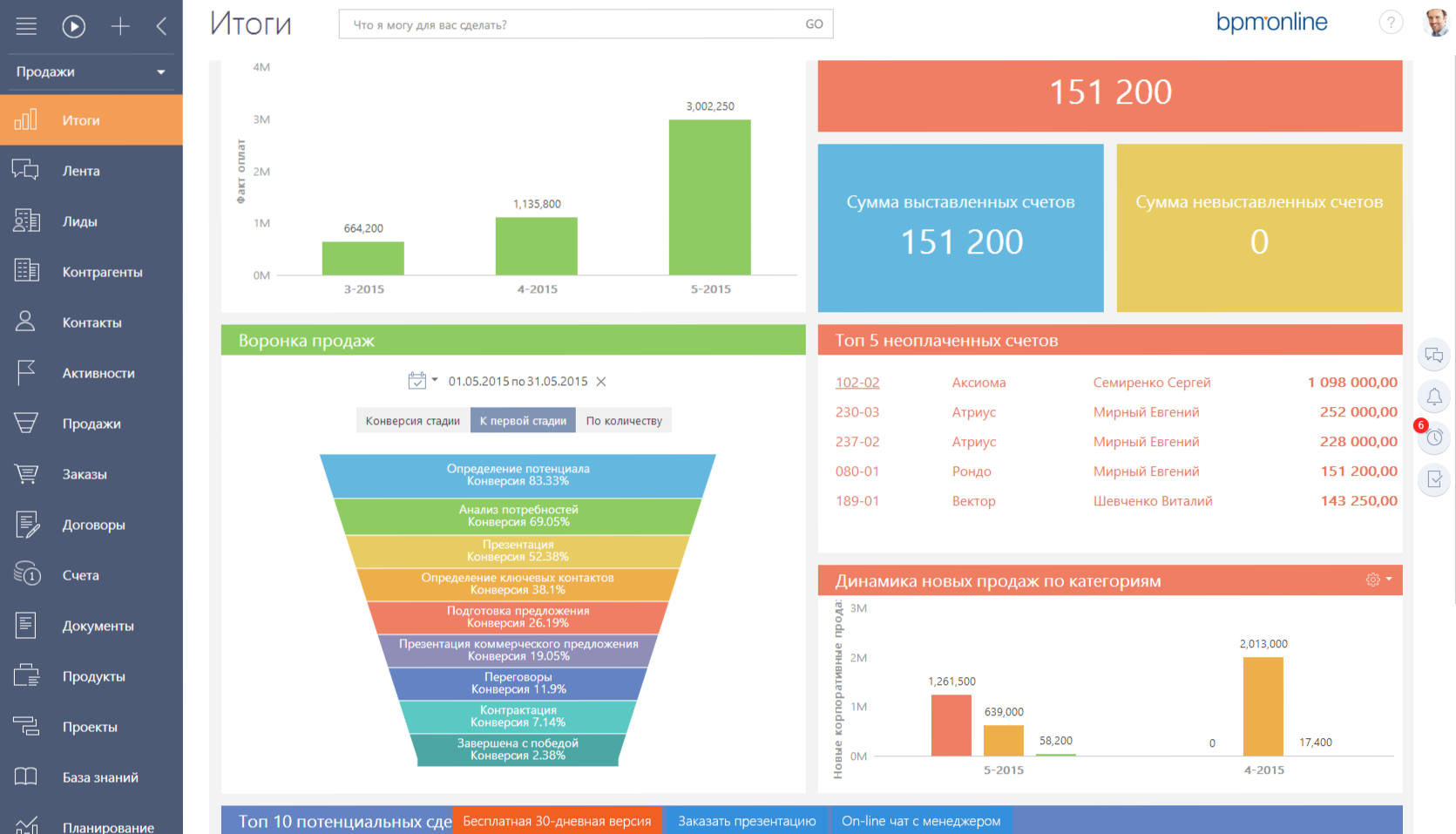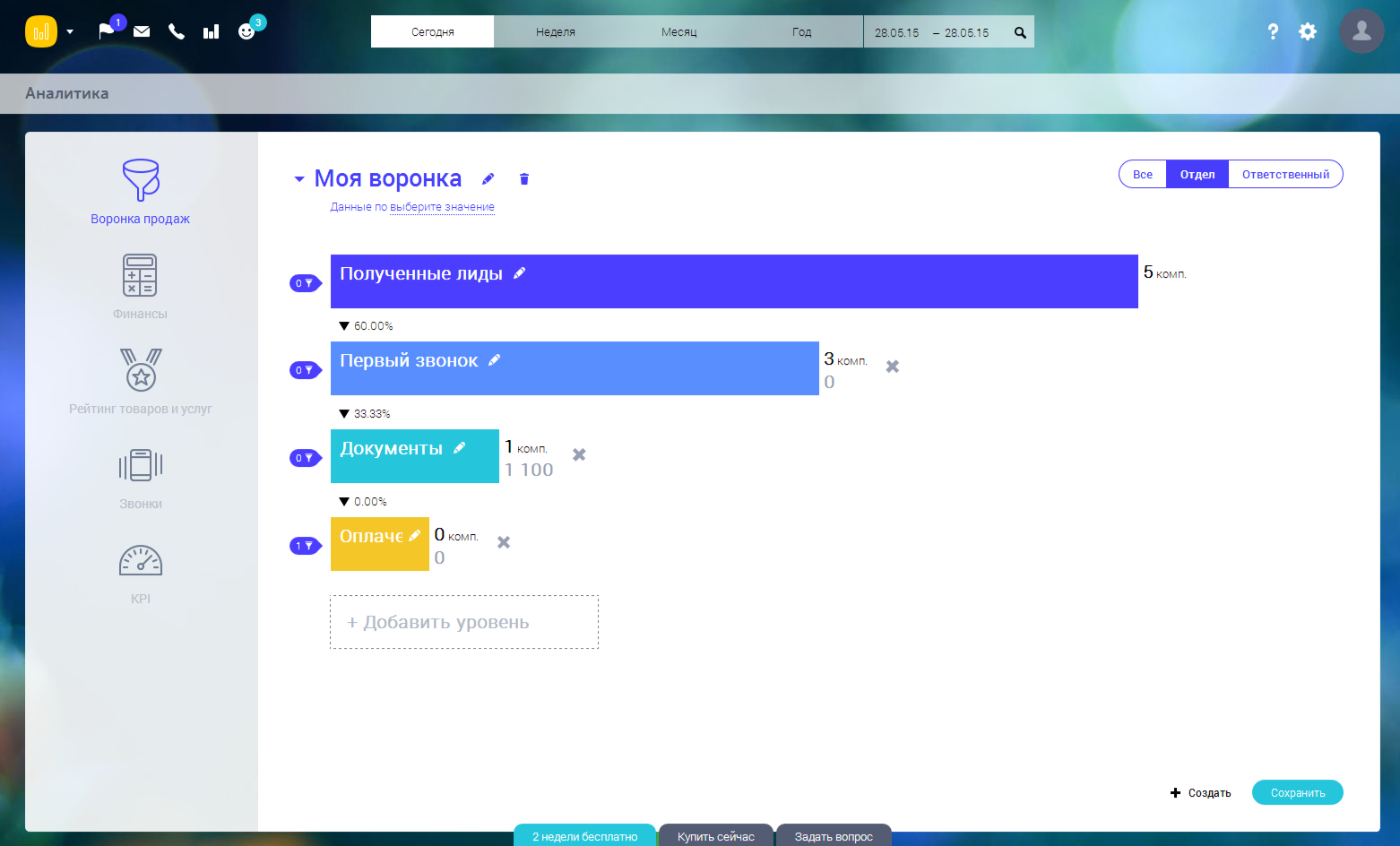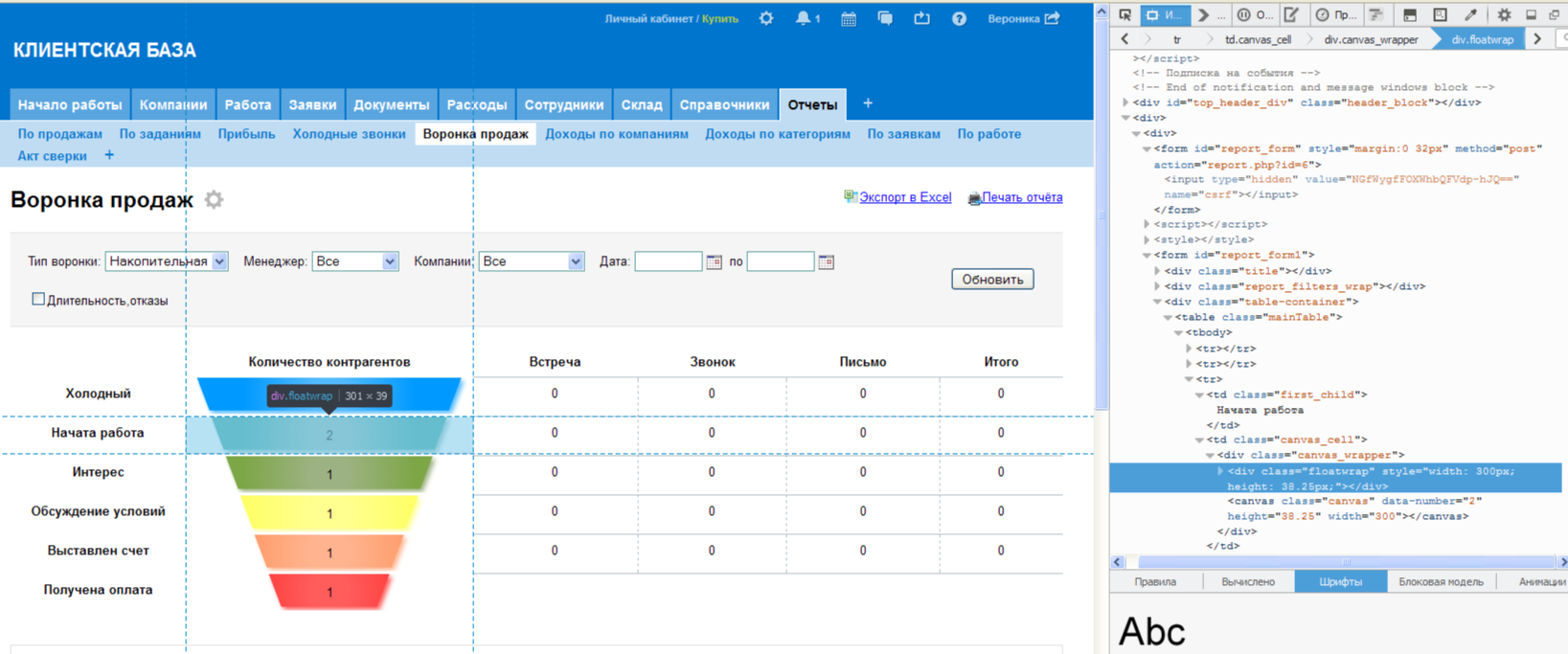Sales funnel in CRM: do not be gadgets, analyze losses
 We will conduct an experience. Take a plastic funnel, close the bottom with a finger, pour half a glass of water. Now we will substitute an empty glass, we will open an opening - exactly half a glass has poured out. Obviously, the tracing from the English term "sales funnel" firmly settled down, but it does not reflect the true essence. Speaking of the sales funnel, from which far fewer customers come out than it has entered, it is easier to imagine a multi-stage filter, on each layer of which sediments are suspended, and the output is quality water. And this image is fair, after all “funnel” means in translation also “to leak, to go outside”.
We will conduct an experience. Take a plastic funnel, close the bottom with a finger, pour half a glass of water. Now we will substitute an empty glass, we will open an opening - exactly half a glass has poured out. Obviously, the tracing from the English term "sales funnel" firmly settled down, but it does not reflect the true essence. Speaking of the sales funnel, from which far fewer customers come out than it has entered, it is easier to imagine a multi-stage filter, on each layer of which sediments are suspended, and the output is quality water. And this image is fair, after all “funnel” means in translation also “to leak, to go outside”.The sales funnel is one of the most odious and at the same time favorite reports of general directors, heads of sales departments, and marketers. Moreover, some managers use it only.
This is understandable - a beautiful, clear, detailed tool is easily implemented even in Excel and at the same time is able to bring an element of infographic into the most boring presentation. Undoubtedly, this report is worthy of a separate review, especially since the developers of almost all CRM implement it, and sometimes even very unusual. Let's try to figure out how the funnels are implemented and what they can give to the manager.
Filter customers!
The essence of the sales funnel is the compilation of an inverted pyramid, at the top of which is unqualified leads, and at the exit is paid transactions, and ideally, after-sales and re-sales. Each company forms its own funnel and identifies the necessary stages of sales, which can begin with two and end with a couple of dozen. However, all stages are reduced to the basic blocks: lack of awareness (the most extensive target audience with a need) → awareness (found out about a brand) → interest (call, letter, etc.) → desire (negotiation, order) → purchase (payment, credit, rent) . And it is precisely the analysis of these blocks allows us to understand what went wrong and why the client leaves.
')
The reasons for leaving potential customers may be different: you didn’t like the product or service, you didn’t have enough money to buy, you lost contacts, changed your mind, the delivery was delayed and so on ... The reason should be set as accurately as possible - then the effect will be adequate (for example, a reminder of payment in the absence of money at the moment). It is also important to track the funnel by managers or groups of managers in order to see the problematic stages and extrapolate the best practices of successful employees or eliminate obvious gaps.
Accordingly, it is important to have a sales funnel in CRM in order to immediately receive auxiliary data and reports for a more in-depth analysis of the identified situation. Sales funnel included in the CRM-system is not accidental, it allows you to determine a number of important points:
- at what stages and in what category is the outflow of customers
- what groups of clients should focus on
- what is the probability of purchase (conversion) when combining various parameters
- extra links and processes in the company and so on ..
Salesforce conducted research and found out that 57% of companies use the sales funnel in their activities and their main goal is to evaluate clients' solvency. However, this is quite a narrow use, because it is the sales funnel that helps to identify, perhaps, the most critical problem - the moments of losing most of the leads and potential customers. Based on the information received, you can begin to reduce and optimize costs and identify promising stages in the development of various groups of clients.
Sales funnels in CRM: a classic in rock
Technically, all CRM funnels are implemented as ... funnels. That is, narrowed to the bottom of the entity with the allocation of stages of sales. But competition would not be competition if each developer did not add something new, different from the rest.
bpm'online (Terrasoft) included a funnel in several implementations in the sales analysis panel. The main sales funnel can be viewed by conversion stage, by conversion to the first stage and by the number of sales at each stage. The right shows the profitability of transactions in the funnel (estimated) and the number of transactions.

On the additional tab you can compare sales funnels for different periods in the same three variations. I think this is the most convenient and visual implementation of the comparison of reports - in one field, you can visually evaluate the critical values and immediately start analyzing them.
Another screenshot

The disadvantages of the bpm'online funnel include the difficulty of building a sales funnel with custom filters, for example, by manager or by individual counterparty - this task requires additional settings. In addition to the sales funnel, Terrasoft created the “Pulse of Sales” panel, which displays all the hot and relevant statistics needed to fully cover the current situation or situation over the period.
And another screenshot

Desktop RegionSoft CRM implements, perhaps, the most classic funnel. CRM generates the “Sales Funnel” report immediately into the finished print form, from which the graph can be sent to the printer or inserted into the required document. A graph can be formed by a variety of parameters: by curator, industries, size and type of customers, and so on. The funnel is graphically constructed, apparently, on the area of the lower base of the components of its trapezium (which is true), so it looks pretty clear. Each stage - a share to the entered stream of clients with indication of relative and absolute values. The names of the stages are in the right field as pointers - the funnel itself is not overloaded with signatures.

In RegionSoft CRM, the funnel template can be configured through the “Administration” menu, in which the user creates any number of profiles with any order of steps. After setup, the created profiles can be selected directly from the window of the “Sales Funnel” report call. By the way, this is the only vendor who initially has a “Additional sale” stage in the directory - the same cherished moment that any company seeks to manage a sales funnel.
In addition to the classic sales funnel, RegionSoft CRM presents another graphical report that is built for each client directly from the card (menu item “Print”) - it shows the points of interaction with the client on one chart - a very useful report that visually displays the history of customer management.

CRM Desktop Client-Communicator offers a funnel in tabular and graphical form with impacts and their number. The table resembles the usual Excel spreadsheet, can be formed by employees, sales stages. The table displays the conversion and duration of the stages. The table helps to quickly assess the number of incoming and outgoing customers for each stage. However, despite the information content, the implementation of Clic CRM loses to the others in visibility and “readability” of the data, the very essence of the funnel is actually lost.

Graphic implementation:

However, Klik has an advantage that other vendors do not have - planning sales funnels. For planning it is necessary to know the number of incoming sales, the duration of the stage, the conversion of transactions. Based on these data, you can make a detailed forecast and then the sales funnel will be considered, including with respect to the available forecast values (plan).
FreshOffice , now completely cloudy, apparently lost a lot of blood during the redesign and has not fully recovered. When deployed, he refused to support Mozilla Firefox and persuaded Google Chrome to download, in which he continued to work steadily, but with some slowdown. New FreshOffice sales funnel is also moving away from the canons. First of all, it is easy to configure - right in the report field, you can rename the stages, create your own parameters with a filter using logical operations and save the created funnels. The funnel itself can be viewed by department, responsible manager or the company as a whole. A filter designer with a variety of filtering and conditioning options greatly expands your sales funnel and makes the report flexible and feature-rich.

By the way, the funnel in FreshOffice can be built not only on the basis of the transaction stage, but also on the data of several other modules: finance, documents, tasks ... This solution expands the possibilities of graphical presentation of data, but already leaves the sales funnel in the classical sense, and is only representation of any data in the form of a funnel. By the way, this cannot be called a FreshOffice innovation - the choice of such a graphical representation of almost any data is possible in Terrasoft analytical dashboards.
Cloud amoCRM includes a slightly modified funnel, which displays the achievements at the sale stages by quantity and by sum. Of the chips - the forecast of future sales, made on the basis of open transactions, their amounts and previous statistics on closed sales. The amount is estimated, the interface honestly warns the user. From the point of view of the analyst and the manager, this figure does not bear any serious burden, but the motivating moment is definitely present - the cherished figures can serve the purpose. Also in the panel provides a graph of the average duration of the transaction - absolutely not superfluous information.

amoCRM is known for its reverent attitude to interfaces (although sometimes to the detriment of functionality), but in the “Deals” section drag-and-drop interactions are implemented in stages using the mouse - a simple, understandable solution. In combination with the sales funnel, this opportunity allows you to “scatter” transactions with the system very quickly. Another thing is that with a large number of transactions this advantage becomes useless.
The cloud "Client Base" provides the user with an absolutely simple funnel with predetermined stages of the transaction that can be customized.

The critical drawback of the funnel - the lack of a graphic representation - only the numbers on the static picture of the funnel are recorded. This fact violates the whole philosophy of the sales funnel and significantly depreciates the report inside this particular CRM. Actually, the secret of such an implementation is simple if you enable FireBug and explore the funnel as an element of a web page. It is created as a table and the color bars are just a cell element.

The sales funnel in the “Client Base” is implemented in two types: cumulative and current. The funnel funnel shows how many leads have passed through each status for a given period of time. Current shows the number of clients in this state at the time of the report. Funnels can be built by manager, company, by combination of filters, for a period. You can also estimate the duration and failures of each of the stages. The additional table provides statistics on the activities of managers at the stages of transactions. Of minor annoyances, after updating the filter, click the “Refresh” button.
It is necessary to customize the sales funnel, and this should be the second action after setting up reference books and before the first client. It must take into account the specifics of the business and meet its goals. It so happens that in companies (especially with the financial services sector) the sales funnel grows to an unimaginable number of stages. This is also not the best solution - such fragmentation can distort conclusions about the reasons for leaving the client. It is better to create several meaningful stages, united by important business logic or process.
For example, the first call, the second call, the third call. In the automatic mode, the configured system will bring dropped calls to failed calls and only the third call or SMS distribution will be successful. But this does not mean that the client left on the first call and returned on the third. Therefore, it is more convenient to create a stage, for example, “Calling with a deposit offer (up to 3 calls)”. And to collect additional information about calls from a separate report, in which the technical and behavioral reasons for the refusal are more obvious.
Also, one should not blindly trust the predictions (yes, it is predictions, not predictions) of the funnel. If you look, for example, at the ratio of perfect cold calls and conversion at 7%, you can assume that if you call ten times more, you can get ten times more customers. This hypothesis is incorrect. Let us turn to simple logic. There are many clients of A - 1000 leads, a conversion of 7%, while within the group at stage 1 10% fell off, stage 2 - 20%, stage 3 - 3%. There are many B - 1000 leads, we expect a conversion of 7%. But the reasons for the “dumps” are distributed differently and as a result, the conversion of the funnel reaches 3% or, for example, 15%. Thus, an accurate prediction can be obtained either on homogeneous processes or on big data. But the failure trends by stages are excellent data for working on weak points in business and customer leaks, as well as for managing the sales cycle in a company.
In order to make a management decision, it is necessary to analyze all the stages of the sales funnel in order to understand the values, goals and basic parameters of the clients with whom it was possible to make a deal. And only on the basis of such a study to initiate new activities.
Thus, a simple basic report in the environment of CRM functionality and data becomes a powerful tool for managing clients and identifying the reasons for their withdrawal. Follow the sales funnel, work with data, take care of customers, because someone loses ... someone loses ... and someone finds.
PS: From review to review, I consider a group of CRM-systems with which I worked, dealt and which I like. This time I decided to expand the list and test new solutions for Habr and me. What a surprise it was when I discovered that many demos were closed, and a couple of requests for demos were ignored. Not the best way to collect leads - the user wants to receive information in response to the registration immediately, and not upon request. In general, guys, your sales funnel was out of reach.
According to the established tradition, we fix the current prices in the table as of June 1, 2015 (the euro exchange rate is 57.72 rubles):
| CRM vendor | bpm'online (Terrasoft) | RegionSoft CRM | Click CRM | Freshoffice | amoCRM | Customer base |
|---|---|---|---|---|---|---|
| CRM version | Sales | 5.0 Professional | 8.0 Trade Prof | Ecosystem | Professional | Rate B |
| Price per license | 400 € - user / year in the cloud 550 € - Pol. on-site | 12 300 rub. / User / forever | 17 400 p. / user / forever | 750r. / user / month 12 900 rub. / User / forever | $ 499 / user / month | 2 $ 10/10 user / month |
| Price for 10 licenses, year of ownership | 230 880r. in cloud / year 317 460r. / forever and ever | 109 500r. forever and ever | 174 000 rub. forever and ever | 90 000 rub. / Year 129 000./ forever | 179 880. / Year | 21 000 rub. / Year |
| Possession | SaaS cloud + server | Server + possible to rent | Server + is a web version | SaaS cloud + server | SaaS cloud | SaaS cloud + server |
Source: https://habr.com/ru/post/259273/
All Articles